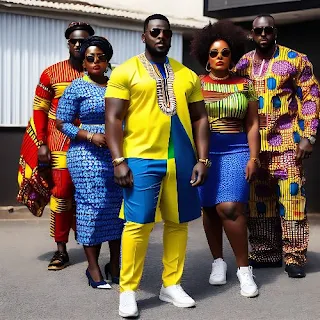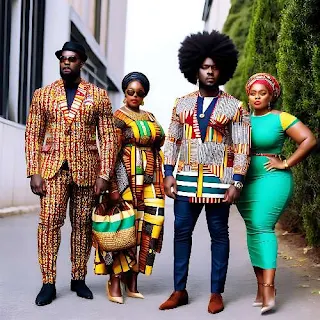The Dynamic Energy of African Fabrics
African fabric designs are often symbolic and have meanings related to spiritual beliefs, social status, and identity.
African cloth and prints have captured the hearts of people worldwide, and their popularity stems from a multitude of reasons. Appreciated for their sheer beauty, cultural significance, versatility, and sustainability, these textiles offer a unique blend of artistry and functionality. Among the vast array of African prints, several have gained international recognition within the fashion industry. Ndebele Print, Ankara Wax Print, Kente Cloth, and Bogolanfini Mud Cloth stand as prime examples, each possessing distinct characteristics that contribute to their widespread acclaim.
Ndebele Print, originating from the vibrant Ndebele culture of South Africa, features geometric patterns in bold and contrasting colors. It reflects the Ndebele people's rich traditions and serves as a visual language, communicating messages of identity, celebration, and social status. Ndebele Print holds a captivating allure for its intricate designs and vibrant hues, making it a sought-after choice in fashion and decor.
Ankara Wax Print, also known as African wax print or Hollandaise, has become an iconic symbol of African fashion. This fabric emerged from the cross-cultural influences of Dutch, Indonesian, and West African textile traditions. Known for its vibrant and eye-catching patterns, Ankara Wax Print represents a fusion of cultural heritage and contemporary style. It has gained popularity for its versatility, being used in a wide range of fashion garments, accessories, and even home decor.
Kente Cloth, originating from the Ashanti Kingdom in Ghana, is recognized worldwide for its intricate handwoven patterns and symbolic meanings. Made of silk or cotton, Kente Cloth holds immense cultural significance, often worn during special occasions and ceremonies. Each pattern and color combination tells a story or conveys a message, reflecting Ashanti proverbs, historical events, or spiritual beliefs. The craftsmanship and artistry involved in creating Kente Cloth make it a cherished textile, revered for its beauty and cultural heritage.
Bogolanfini Mud Cloth, hailing from Mali, is revered for its organic and earthy appeal. This traditional textile is handmade using a unique dyeing process that involves applying fermented mud and natural pigments onto the fabric. The resulting patterns and motifs showcase a raw, rustic aesthetic, often featuring geometric designs or symbols rooted in Malian traditions. Beyond its visual appeal, Bogolanfini Mud Cloth also embodies sustainability, as the production process relies on natural materials and traditional techniques.
The fashion industry has recognized the allure and cultural significance of these African prints, incorporating them into clothing lines, accessories, and even high-end designer collections. Whether it's the bold geometric patterns of Ndebele Print, the vibrant and expressive Ankara Wax Print, the storytelling motifs of Kente Cloth, or the organic beauty of Bogolanfini Mud Cloth, these African prints offer a captivating glimpse into the rich cultural heritage and artistic traditions of the continent.
Guide to the Different Types and Meanings of Traditional African Fabrics.
Usually, African cloth is made using traditional hand-weaving techniques and natural dyes, which are more sustainable and eco-friendly than modern textile production methods. Wearing African cloth can therefore be seen as a way to support sustainable fashion practices and promote ethical fashion. African cloth is versatile and can be used to make a wide range of clothing, accessories, and home decor items. From dresses and skirts to headwraps and bags, African cloth can be tailored to suit different styles and occasions.
The world loves and respects African cloth for its beauty, cultural significance, versatility, and sustainability.
Ndebele Print is often used to adorn clothing, beadwork, and household objects such as blankets and pillows. The designs are highly symbolic and often have specific meanings, such as representing aspects of nature, social status, or spiritual beliefs.
One of the most well-known Ndebele Print designs is the isicholo, a type of headdress worn by married women. Isicholo is typically made of woven grass and decorated with intricate beadwork and geometric patterns that indicate the wearer's social status and identity.
In recent years, Ndebele Print has gained popularity as a fashion trend, with designers incorporating bold, graphic designs into their collections. The use of Ndebele Print has also become a way to celebrate and promote South African cultural heritage.
Ankara Print Design.
The print is made using a wax-resistant dyeing technique called batik and is commonly used to make traditional African clothing such as dresses, skirts, and shirts.
Ankara print, also known as African print, is a colorful and vibrant fabric that is commonly associated with African clothing styles. It is characterized by its bold, geometric patterns and bright colors, and is often made from cotton or a cotton blend.
The Ankara print originated in West Africa, specifically in Nigeria, and has since spread throughout the continent and the world. It is a symbol of African cultural identity and heritage and is often used in traditional celebrations and ceremonies.
In recent years, the Ankara print has become popular in mainstream fashion, with designers incorporating it into their collections and fashionistas incorporating it into their everyday wardrobes. The versatility of the fabric has allowed for it to be used in a variety of styles, from dresses and skirts to pants and jackets.
Kente Cloth Print Design
Newer types of kente cloth feature bright, bold colors, usually red black, and green. The red stands for the blood shed by African people, the black symbolizes black African heritage, and the green symbolizes the wealth and fertility of Africa. Kente cloth has a long and rich history in Ghanaian culture, and it is traditionally worn by royalty and for special occasions such as weddings, funerals, and festivals.
The process of making kente cloth is labor-intensive and requires great skill and patience. The threads are carefully selected and dyed using natural pigments, and then woven together on a loom to create intricate patterns. The weaving is done by hand, with each weaver responsible for a specific section of the cloth.
Today, kente cloth is not only worn in Ghana but is also popular in other parts of Africa and around the world. It has become a symbol of African heritage and identity, and many people wear it as a way to express their cultural pride. Kente is a traditional African print that originated in Ghana and is commonly used to make ceremonial clothing such as robes, head wraps, and shawls.
Bogolanfini cloth, also known as Mud Cloth is a traditional African textile made by the Bamana people of Mali, West Africa.
The process of creating bogolanfini cloth is quite intricate and time-consuming. First, the cotton fabric is woven into strips and sewn together to create the desired size of the cloth. Then, the fabric is dyed with a natural dye made from the leaves of the n'gallama tree, which gives it a yellowish-brown color.
Next, a mixture of water and mud is applied to the fabric in order to create resistance, which is used to create the patterns. The mud is collected from riverbanks and is mixed with leaves, bark, and other natural materials to create different shades of color.
Once the resist has dried, the cloth is washed to remove the mud, revealing the intricate patterns and designs created by the resist. The process can be repeated several times in order to create more complex designs with multiple layers of resist.
Mud cloth is commonly used to make clothing, accessories, and home decor items such as pillow covers and wall hangings. Today, bogolanfini cloth is seen as a symbol of African culture and heritage, and its popularity continues to grow both in Africa and around the world.
People love African cloth and prints for their beauty, cultural significance, versatility, and sustainability. Ndebele Print, Ankara Wax Print, Kente Cloth, and Bogolanfini Cloth are four widely known and loved African prints.
















